Book contents
- Frontmatter
- Contents
- Series preface
- Preface
- 1 Introduction
- 2 Towards The General Theory
- 3 The General Theory of employment
- 4 Consumption and investment
- 5 Money, finance and the rate of interest
- 6 Equilibrium, change and time
- 7 Harrod and dynamic economics
- 8 Robinson on the accumulation of capital
- 9 Conclusion
- References
- Indexes
8 - Robinson on the accumulation of capital
Published online by Cambridge University Press: 24 October 2009
- Frontmatter
- Contents
- Series preface
- Preface
- 1 Introduction
- 2 Towards The General Theory
- 3 The General Theory of employment
- 4 Consumption and investment
- 5 Money, finance and the rate of interest
- 6 Equilibrium, change and time
- 7 Harrod and dynamic economics
- 8 Robinson on the accumulation of capital
- 9 Conclusion
- References
- Indexes
Summary
INTRODUCTION
Both as a member of the ‘Circus’ and as a commentator on drafts of The General Theory, Joan Robinson was very much involved in Keynes's transition from the Treatise to The General Theory. Not only was she an important expositor of the General Theory, but she also tried to extend its scope. Robinson fully understood that Keynes's formal analysis was limited to short-period equilibrium, and she recognised how it enabled him to arrive at an understanding of the factors determining the level of employment at any point in time. With this limitation, however, there was the inevitable question for anyone raised in the Marshallian tradition like Robinson about how the analysis could be extended to deal with the long period.
Robinson's first attempt at making this extension was undertaken even before The General Theory was published. She wrote to Keynes, in a letter dated 19 June 1935, that ‘I have been working out this long-period stuff’ (Keynes 1973b: 648), a reference to her paper ‘The Long-Period Theory of Employment’ in Robinson (1947), most of which was first published in Zeitschrift für Nationalökonomie in 1936. This paper was very much a beginning exercise, and it was restricted to the comparison of positions of stationary (long-period) equilibrium that differed because of differences in the rate of interest, or in the degree of thriftiness, or in technology.
- Type
- Chapter
- Information
- Keynes's General Theory and Accumulation , pp. 166 - 187Publisher: Cambridge University PressPrint publication year: 1991



